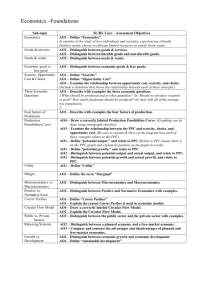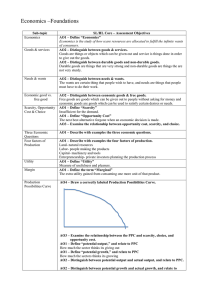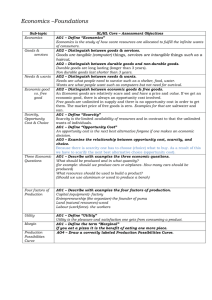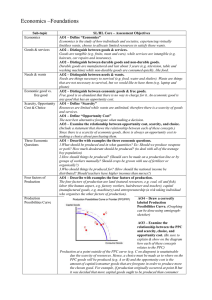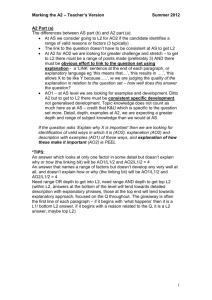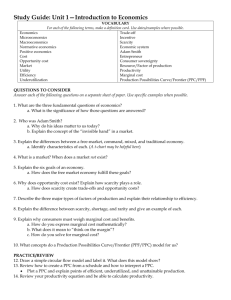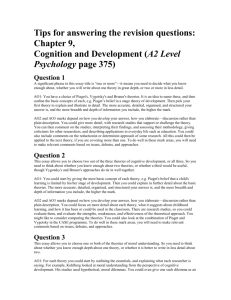foundations-syllabus edited
advertisement
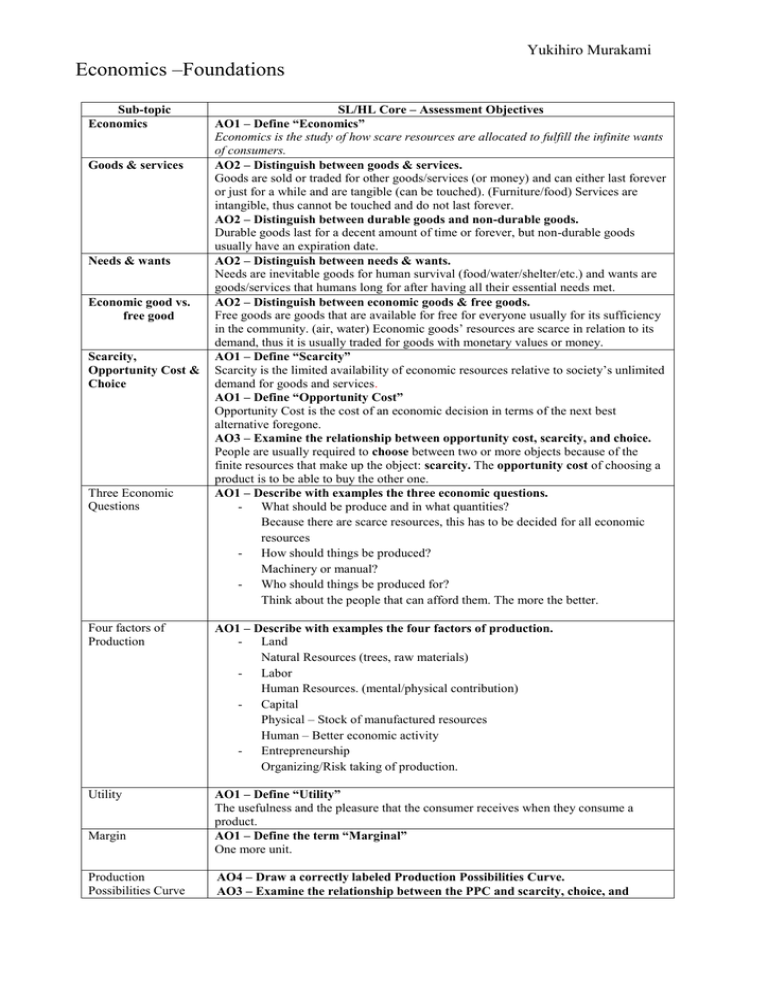
Yukihiro Murakami Economics –Foundations Sub-topic Economics Goods & services Needs & wants Economic good vs. free good Scarcity, Opportunity Cost & Choice Three Economic Questions SL/HL Core – Assessment Objectives AO1 – Define “Economics” Economics is the study of how scare resources are allocated to fulfill the infinite wants of consumers. AO2 – Distinguish between goods & services. Goods are sold or traded for other goods/services (or money) and can either last forever or just for a while and are tangible (can be touched). (Furniture/food) Services are intangible, thus cannot be touched and do not last forever. AO2 – Distinguish between durable goods and non-durable goods. Durable goods last for a decent amount of time or forever, but non-durable goods usually have an expiration date. AO2 – Distinguish between needs & wants. Needs are inevitable goods for human survival (food/water/shelter/etc.) and wants are goods/services that humans long for after having all their essential needs met. AO2 – Distinguish between economic goods & free goods. Free goods are goods that are available for free for everyone usually for its sufficiency in the community. (air, water) Economic goods’ resources are scarce in relation to its demand, thus it is usually traded for goods with monetary values or money. AO1 – Define “Scarcity” Scarcity is the limited availability of economic resources relative to society’s unlimited demand for goods and services. AO1 – Define “Opportunity Cost” Opportunity Cost is the cost of an economic decision in terms of the next best alternative foregone. AO3 – Examine the relationship between opportunity cost, scarcity, and choice. People are usually required to choose between two or more objects because of the finite resources that make up the object: scarcity. The opportunity cost of choosing a product is to be able to buy the other one. AO1 – Describe with examples the three economic questions. - What should be produce and in what quantities? Because there are scarce resources, this has to be decided for all economic resources - How should things be produced? Machinery or manual? - Who should things be produced for? Think about the people that can afford them. The more the better. Four factors of Production AO1 – Describe with examples the four factors of production. - Land Natural Resources (trees, raw materials) - Labor Human Resources. (mental/physical contribution) - Capital Physical – Stock of manufactured resources Human – Better economic activity - Entrepreneurship Organizing/Risk taking of production. Utility AO1 – Define “Utility” The usefulness and the pleasure that the consumer receives when they consume a product. AO1 – Define the term “Marginal” One more unit. Margin Production Possibilities Curve AO4 – Draw a correctly labeled Production Possibilities Curve. AO3 – Examine the relationship between the PPC and scarcity, choice, and Yukihiro Murakami Microeconomics vs. Macroeconomics Positive vs. Normative Econ Ceteris Paribus Circular Flow Model Public vs. Private Sectors Rationing Systems opportunity cost. PPC graphs show how efficiency is an important role considering the scarce resources. We cannot go beyond the potential line, because of the scarce resources. Manufacturers’ choices come from supply and demand, and create more of the product that is being demanded. The opportunity cost of creating one product, is being able to produce the other. AO1 – Define “potential output,” and relate to PPC Products that could be produced if all resources were used efficiently, any point on the AO1 – Define “potential growth,” and relate to PPC Increase in the economy’s capacity to increase, dot on the outside the PPC line. The whole line shifts outward. AO2 – Distinguish between potential output and actual output, and relate to PPC. Potential output is what the economy should/could be doing, and actual output is what the economy is actually doing. Potential output is on the PPC line while the actual output is inside the PPC line. AO2 – Distinguish between potential growth and actual growth, and relate to PPC. Potential growth occurs only when there is an increase in the quality/quantity of the factors of production and actual growth occurs when all the resources are not wasted and are used efficiently. Potential growth moves from PPC line to outwards and actual growth moves from the inside of the PPC line towards the PPC line. AO2 – Distinguish between Microeconomics and Macroeconomics. Microeconomics refers to smaller scales such as private companies and firms. Macroeconomics refers to larger scales such as the whole economy’s economic status. AO2 – Distinguish between Positive and Normative Economics with examples. Positive economics is a statement that can be supported by facts and evidences. (Men drink more beer than women) Normative economics is a statement that cannot be supported by facts or evidence. Usually one’s opinion. (The gasoline price is too high in the United States.) AO1 – Define “Ceteris Paribus” Ceteris Paribus: Changing one of the variables in a theoretical testing model to see what the outcome will be. All other things being equal. AO1 – Explain the reason Ceteris Paribus is used in economic models. When economists want to test the effect of one variable to another, he does so by changing one of the factors and leaving the other untouched. AO4 – Draw a correctly labeled Circular Flow Model. AO2 – Explain the Circular Flow Model. The households supply the four factors of production to the firms/companies. The firms provide Rent, Wages, interest, and profit back to the households. (factors market) The households pay expenditure, or give something with monetary value to the firms. The firms supply the households with goods and services. (products market AO3 – Distinguish between the public sector and the private sector with examples. Public sector: Owned by and cared by the government. (Infrastructure) Police stations, fire fighters, etc. In a command economy, everything is in the public sector. Private sector: Owned by private firms and companies. (Products) Only for free or mixed markets. AO2 – Distinguish between a planned economy and a free-market economy. In a planned economy, the basic economic problems are taken care of by the government. In short, the government owns everything. In a market economy, the government does not control anything and the decisions are left for the people. People make the decision on the basic economics problem. AO3 – Compare and contrast the advantages and disadvantages of planned and free-market economies. P Advantages P Disadvantages F Advantages F Disadvantages - Secure jobs. - No incentives - Lots of - Unsecure jobs. - Retirement to work. incentives to - One company plan laid out. - Long queues to work. may be too - Medical plan buy a product. - People have strong resulting for everyone. - No choices. their choice on in a monopoly. what they want to do. Yukihiro Murakami Growth vs. Development AO2 – Distinguish between economic growth and economic development. Economic growth is when there is an increase in the level of real national income between one year and another. Economic development is a measure of welfare and well-being. Measures in GDP, but also in other nonmonetary terms such as education indicators, health indicators, and social indicators. AO1 – Define “sustainable development” Sustainable development: Development that meets the needs of the present without compromising the ability of future generations to meet heir own needs. Yukihiro Murakami
